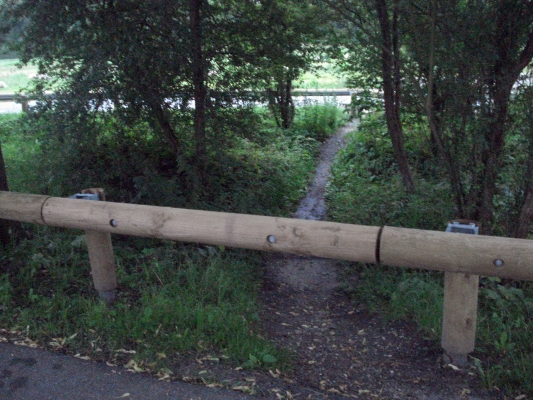Researchers interpret clandestine walking paths
Posted on November 12, 2013

An informal "goat path," worn by pedestrians taking the easiest route to their destination.
Recently OTREC took a look at suburbia to see how many people were walking and biking to local destinations.
Traditionally, studies of suburban locations have found that due to the low density of suburban areas and their single-land-use patterns, active transportation is rare.
In a research project by Principal Investigator Nico Larco and Co-Investigator Robert Parker, of the University of Oregon, active transportation was found to be more common than expected in suburban areas with commercial strip destinations.
In their project “Overlooked Destinations: Suburban Nodes, Centers, and Trips to Strips,” Larco and Parker observed active travel behaviors around typical suburban commercial sites. They examined six strip malls -- four in Portland, Ore. and two in Atlanta, Ga. -- to map out the “pedshed,” or walkable zone surrounding these sites.
Investigators were surprised by what they found.
For each site, they created detailed pedestrian-network GIS maps. They compared the network extents of maps that included only publicly available, street centerline data with maps that included pedestrian networks derived from aerial images and “on-the-ground” site audits.
Around each site, in addition to the formal pedestrian network of roads and sidewalks, they discovered a network of “goat paths,” or informal walking paths through vacant land and cuts in fences worn into existence by the residents. These paths extended the pedsheds, substantially increasing the number of residents able to walk to these destinations.
This indicates more walking and biking than previous suburban studies have indicated. These areas, though they already host a significant amount of active travel, have the potential to support much more. If these informal paths were made more welcoming (by adding lighting, for example, or ensuring that they do not cut across private land), more people might use them.
Researchers also sent out surveys to residents living near the strip malls, collecting information about their mode choice behaviors. Twenty percent of households living within one-third of a mile of a suburban commercial strip reported that they regularly use transit at the strip, and most of them walk or bike to those transit stops.
Factors such as convenience, health, enjoyment and saving money all affected mode choice. Though the sample size of six sites is limited, Atlanta and Portland arguably represent two extremes between auto-centric and pedestrian-oriented culture. Between these two extremes, there was little or no variation in the active travel behavior of people living within the walkable zone, suggesting that there may be a pent-up demand for active travel options across the board, regardless of location.
Survey responses indicated that nearly one-third of residents would choose active travel more frequently if there were better places to walk available.
Given these results, Larco and Parker recommend future research to look into best practices for making suburban commercial destinations more hospitable to pedestrians and cyclists. Findings from this research indicate that the potential exists for an increase in active travel in suburban areas.
For more details, click here to download the final report.
